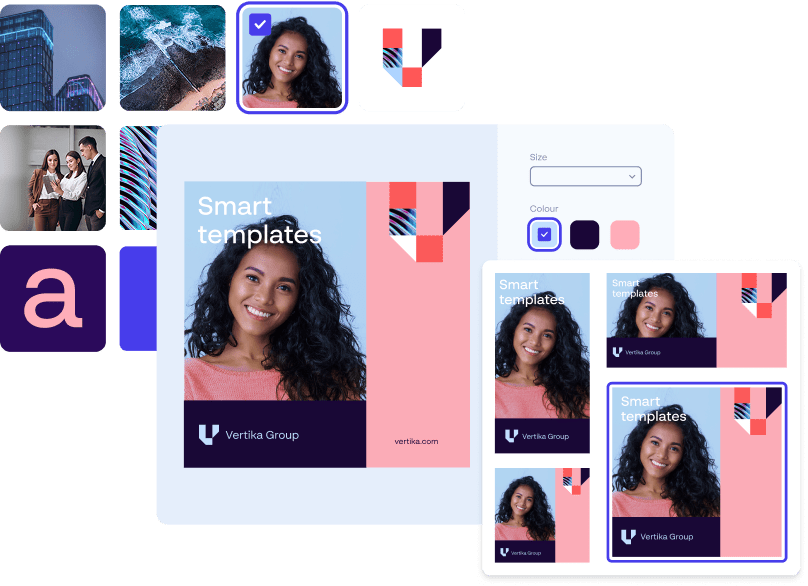Choosing the best template design software for your organization is critical. Get it wrong and you risk losing money, slowing content production, and eroding brand trust. But with hundreds of visual content tools out there, how do you select the best software for template design? Equally important, how do you know which solutions are actually fit for enterprise needs?
This blog breaks down the top seven visual content creation tools, highlighting how they differ—and why only a few can truly scale brand-compliant content creation in global organizations.
What makes a design template platform truly enterprise-ready?
“Templates” are everywhere—but their functionality varies wildly. Some tools optimize for speed and visual appeal. Others prioritize automation. Few are built to meet the compliance, localization, and workflow needs of complex teams managing multi-market brands.
To bring clarity to a crowded market, we’ve divided the best content creation software solutions into three categories:
- Consumer design platforms – intuitive but risky for brand control
- AI-powered content generators – fast but often generic
- Enterprise templating solutions – purpose-built for brand governance at scale
How consumer design platforms are easy but lack control
1. Canva
Loved by individuals and small businesses, Canva offers over 250,000 templates. But with little control over brand assets, fonts, or layouts, it falls short of enterprise-grade governance.
Best for: Social media, small team marketing, freelance creatives
2. Adobe Creative Express
Backed by Adobe’s reputation, this tool offers premium imagery and editing for a small monthly fee. However, brand controls remain light, and enterprise collaboration features are limited.
Best for: Creative professionals in the Adobe ecosystem
3. Figma – Powerful, but steep learning curve
Figma’s collaborative UI/UX environment is ideal for product designers. However, its professional depth can overwhelm non-designers, making it impractical for company-wide templated content creation.
Best for: Design teams and system builders
AI-powered platforms provide automation but lack brand alignment
4. Gamma
Gamma uses prompts to generate slide decks automatically. It’s great for speed but often misses the nuance of tone, hierarchy, and messaging. Limited brand alignment means risk for enterprises.
Best for: Individual productivity and fast ideation
5. Jasper Art
AI-generated imagery can support content workflows—but authenticity often suffers. Jasper Art’s outputs may impress visually, but they rarely meet brand or compliance standards.
Best for: Fast content experimentation, not brand-led execution
Enterprise templating blends creativity and brand compliance
6. Templafy
Templafy integrates tightly with Microsoft Office, making it ideal for legal and compliance-heavy teams. But it’s not built for modern marketing or brand activation.
Best for: Policy documents, legal templates, enterprise file compliance
7. Papirfly: The enterprise templating solution built for scale
Papirfly stands alone in combining global governance with local empowerment, enabling marketers across departments, regions, and skill levels to create high-quality, on-brand assets at scale.
Why Papirfly is the best template design software for enterprises
- Locked templates with flexible inputs
Papirfly’s templated content creation enables any user, including non-designers, to produce studio-quality, on-brand assets at scale using locked brand templates, ensuring compliance with guideline elements like logos, fonts, and color palettes. - Liquid Layout Technology
With automated resizing through Papirfly’s fluid UI and layout system, marketing teams can instantly adapt branded content for print, social channels, and ad formats. No manual cropping or re-design required. - Global localization built-in
Papirfly empowers local, regional, and affiliate teams to localize and customize pre-approved templates while keeping core brand elements protected and providing instant export options for print-ready PDFs and digital assets. - Multi-format on-brand templates
Create and manage brand-compliant templates for every major format—including video, email, social media, print and digital documents, and banner ads. Ensure consistent branding across all channels and touchpoints. - InDesign import & campaign integration
Convert existing InDesign files into flexible, editable templates in seconds using Papirfly’s integrated import workflow—streamlining the production of global assets and accelerating time-to-market. - Enterprise-grade workflow control
Team members can create, approve, and publish customized templates across multiple channels using Papirfly’s role-based workflow—helping brands centralize control, automate approvals, and empower rapid production. - Interconnected with your tech stack
Integrate Papirfly’s template builder and DAM with business-critical platforms like Adobe Creative Cloud, Figma, CRMs, and CMSs for seamless brand asset management and campaign activation. - Unified platform architecture
The Papirfly suite combines DAM, Templated Content Creation, and other brand management tools so enterprises can manage collateral, enforce brand governance, and deliver consistent campaigns with a single solution.
Best for: Mid-market and enterprise organizations prioritizing brand compliance, speed-to-market, and global execution.
Strategic comparison: Which tool is right for your business?
| Use Case | Recommended solution |
|---|---|
| Small teams (under 10) | Canva, Adobe Creative Express |
| Creative departments | Figma, Adobe Creative Express |
| Document-heavy workflows | Templafy |
| Mid-market with growth plans | Papirfly |
| Enterprise, global brand ops | Papirfly |
Only Papirfly’s design templates scale for brand governance
Consumer platforms focus on creative freedom. AI tools chase speed. Most enterprise tools handle one challenge well, rarely all.
Papirfly bridges the gap between creative enablement and brand control. It’s not just a templating tool. It’s a scalable solution to modern content operations, enabling every team to build trust through brand consistency—at speed, and at scale.
Ready to scale on-brand content creation?
Discover why leading brands trust Papirfly
Ready to scale on-brand content creation?
Discover why leading brands
trust Papirfly
Discover why leading brands trust Papirfly

FAQs
Consumer tools prioritize design flexibility but lack control. Enterprise tools like Papirfly ensure brand compliance, scalability, and workflow management.
Papirfly integrates with your DAM and creative suite while enhancing their capabilities through intelligent templates and brand governance.
With dataset-driven templates and multi-market content orchestration, Papirfly enables localized, compliant content creation without compromising brand identity. This makes Papirfly one of the most effective content creation tools for social media, among other things.
Global marketing teams, brand managers, and local market contributors who need to create fast, on-brand content without relying on designers. Papirfly’s brand portals ensure every team can adopt brand guidelines.
Yes. Papirfly supports compliance workflows, GDPR consent managemnet, role-based permissions, and audit trails. The modular suite makes it ideal for regulated sectors like finance, healthcare, and pharma to build their compliant brand ecosystem according to their needs.
Table of contents:
- What makes a design template platform truly enterprise-ready?
- How consumer design platforms are easy but lack control
- AI-powered platforms provide automation but lack brand alignment
- Enterprise templating blends creativity and brand compliance
- Why Papirfly is the best template design software for enterprises
- Strategic comparison: Which tool is right for your business?
- Only Papirfly’s design templates scale for brand governance
- FAQs


